Innovative Steelmaking Process: Facilities for Secondary Refining and Continuous Caster Start Operation
2009.12.22
- Sumitomo Metal Industries, Ltd.
- Sumitomo Metals (Kokura), Ltd.
Sumitomo Metal Industries, Ltd. (Sumitomo Metals) has been proceeding with investments in innovative steelmaking processes at Sumitomo Metals (Kokura), Ltd. The main facilities are for secondary refining(*1), namely, the No. 2 LF refining facility (2LF)(*2) and the No. 2 RH degassing facility (2RH)(*3),for the No. 4 continuous caster (4CC), and for a phosphorous removal furnace. Among these, construction of the 2LF, 2RH, and 4CC has been completed. Accordingly, a completion ceremony was held today and operation has begun.
Steel contains non-metallic inclusions such as oxides and sulfides that have not been dissolved. Sumitomo Metals (Kokura) produces two types of specialty steels: super functional steel and super clean steel. Super functional steel performs aimed functions such as advanced workability that enables to actively disperse and control non-metallic inclusions. Super clean steel has a longer life and improved fatigue characteristics, as non-metallic inclusions are almost completely removed. As a result of the investments, manufacturing processes have been completely separated for the two types of products through the establishment of a super functional steel production line (consisting of the newly constructed 2LF-2RH-4CC) and a super clean steel production line (consisting of the existing VAD(*4)-1RH-3CC.) By enabling optimal processes to be applied for each product and simplifying logistics in the factory, improvements in quality and efficiency have been achieved.
A phosphorous removal furnace is also under construction, with completion targeted in October 2010. The objective for this investment is to introduce the Simple Refining Process(*5), which separates the removal process of phosphorous and carbon and enables the achievement of higher quality, greater efficiency, and a lower environmental burden.
Investments in innovative steelmaking process
1. Total investment amount: 27 billion yen
2. Construction period
First phase : Construction of the 2LF, 2RH, and 4CC facilities from February 2007 to December
2009
Second phase : Construction of a phosphorous removal furnace from February 2007 to October
2010
Features:
- Complete separation of manufacturing processes for super clean steel and super functional
steel through construction of the new 2LF, 2RH, and 4CC facilities.
- Introduction of the SRP through construction of a phosphorous removal furnace
<Reference>
1. Completion ceremony
(1) Time and date: Starting at 11:00 a.m. on Tuesday, December 22, 2009
(2) Ceremony organizer: Yoshimitsu Kato, President of Sumitomo Metals (Kokura), Ltd.
(3) Attendees: Approximately 60 people including the Chief Executive of Industry and Economics Bureau of Kitakyushu City, representatives of construction-related companies, labor union representatives, representatives of affiliates, and the president and other directors of Sumitomo Metals (Kokura)
2. Conceptual diagrams of complete separation of manufacturing processes for super clean steel and super functional steel
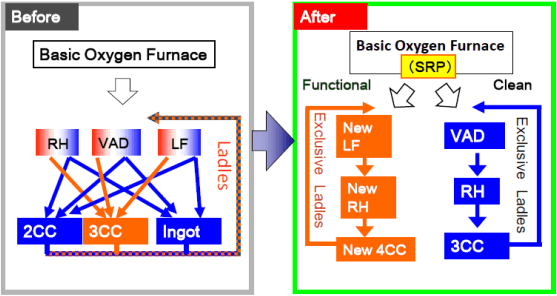
<Glossary>
*1 Secondary Refining
The steel refining process is divided into two categories: primary refining, which is designed to remove carbon from pig iron, and other refining processes conducted after the primary refining, which are collectively called secondary refining. Secondary refining removes impurities and adjusts elements. Secondary refining usually takes place in the ladle, a transportation vessel for molten steel. It is very important for the production of high-grade steel. Examples include LF, RH, and VAD.
*2 LF (Ladle Furnace)
A secondary refining process whereby molten steel is heated in ladles using an electric arc. The LF process is effective in reducing sulfur and controlling non-metallic inclusions in molten steel.
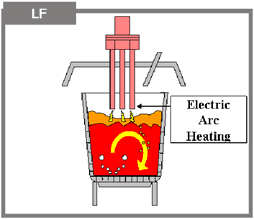
*3 RH (Ruhrstahl-Heraeus)
The RH process is composed of a vacuum vessel and two tubes (suction tubes) immersed in molten steel in a ladle. The molten steel is sucked into the vacuum vessel through one suction tube at which point argon gas is injected. The molten steel then flows out back to the ladle through the other suction tube. This process enables continuous vacuum-treatment of molten steel in a ladle.
During the RH refining process, degassing and intensive stirring take place in the vacuum vessel. This facilitates agglomeration of non-metallic inclusions, which then float to the surface. This process is therefore effective in reducing non-metallic inclusions.
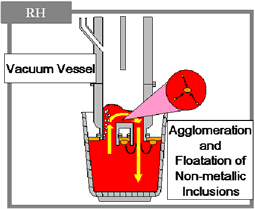
*4 VAD (Vacuum Arc Degasser)
Similar to the LF process but with a vacuum degassing vessel. The most harmful non-metallic inclusions are oxides, and this process is more effective in reducing oxide inclusions than LF.
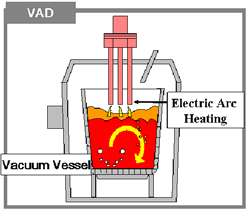
*5 SRP (Simple Refining Process)
This is a technology that entails using two difference furnaces to separate removal processes of phosphorus and carbon, by applying a top and bottom blown basic oxygen furnace for phosphorous removal. By setting optimal conditions for each stage of refining, Sumitomo Metals achieved three goals simultaneously: higher quality (phosphorous impurity of less than 8 ppm), greater efficiency (9-minute refining time) , and a lower environmental burden (significant reduction of slag and less emission of
CO2 . ) This innovative steelmaking process was commercially applied for the first time at Sumitomo Metals' Wakayama Steel Works and has become a de facto standard. It was awarded the Okochi Grand Production Prize in 2006.
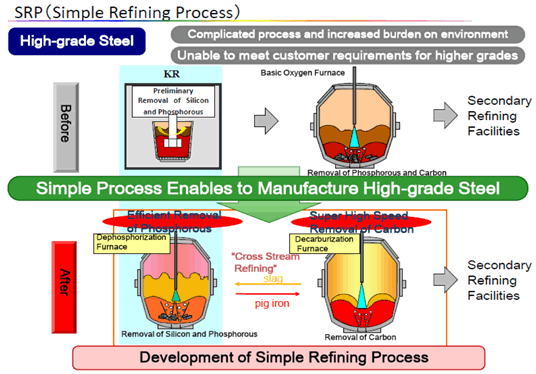
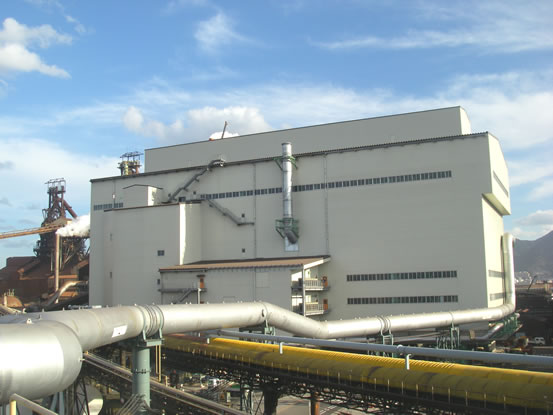
New 2RH&4CC, Plant facility
